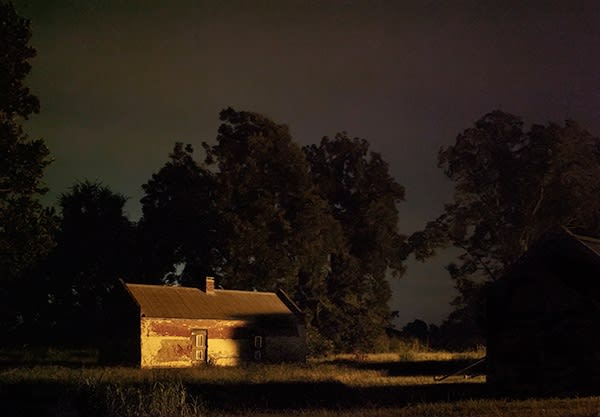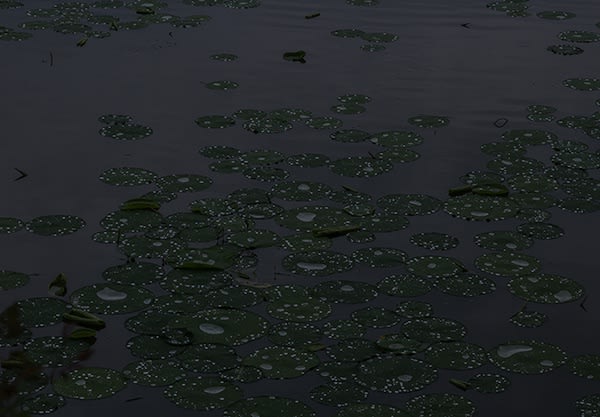As children, many of us first imagine the Underground Railroad as a literal train with Harriet Tubman as its conductor. The historical reality is that this metaphorical railroad delivered an estimated 100,000 passengers to freedom through an ever-changing network of abolitionists, and Harriet Tubman was but one of several conductors. Born from one of the darkest eras in our history, the mythos of the Underground Railroad remains instilled within the American cultural imaginary. Photographer Jeanine Michna-Bales brings human dimension to this mythic conception of the Underground Railroad in her exhibition “Through Darkness to Light: Seeking Freedom on the Underground Railroad,” on view at Arnika Dawkins Gallery through April 14, 2017.
“Through Darkness to Light” documents a path of historic sites and landscapes that fugitive slaves would have journeyed through on the “railroad” to freedom. Michna-Bales spent years working on the research and execution of her photo-essay, tracing the steps of people who traveled almost 1,400 miles from the Southern plantations of Louisiana to the Canadian border. Traveling under cover of darkness, fugitive slaves would often hike 20 miles each night, traversing rough terrain and evading all the obstacles that mother nature, and man, could throw in their path. The series presents a sequence of haunting nocturnal images that capture the journey of the Underground Railroad from the perspective of those who traveled it.

Decision to Leave, 2013; Magnolia Plantation on the Cane River, Louisiana
Michna-Bales shot her photographs after dark, capturing the beautiful but unsettling atmosphere of the landscapes—all seemingly frozen in time, untouched by the modern world. When possible, she relied on moonlight to illuminate the images. On darker nights, however, she resorted to the photographic technique of “light painting,” shining a flashlight around the scene during long exposures to brighten the setting. The resulting effect presents viewers with images that are enigmatic and dreamy but also vivid and unnerving.
While the exhibition consists of 15 images, the series as a whole comprises 80 photographs, all of which are published in Michna-Bales’s book of the same title. The visual narrative of the exhibition begins with Decision to Leave, with the viewer transported to the Magnolia Plantation on the Cane River in Louisiana, the beginning of the journey to freedom. The photo depicts a twilight scene where residual daylight lingers on the face of a plantation building as the viewer—now seeing through the eyes of a fugitive slave—looks back one last time.

Off the Beaten Path, 2014; Along the Yockanookany River, Mississippi
Following a map posted in the gallery of Michna-Bales’s specific path, the next site featured in this exhibition is Cypress Swamp, located along the Yockanookany River in middle Mississippi, of which there are three photographs. Swamps have long been part of the allure of the South, its landscape and mythology. Their floating islands and unusual flora only add to their spookiness, mystery, and appeal. Off the Beaten Path offers a new interpretation of this landscape. Droplets of water on the camera’s lens blur the scene and place the viewer in the position of a fugitive slave quietly wading through the marsh in the darkness. An experience that was once the subject of great lore becomes distinctly human, allowing viewers new insight into the haunting reality of the Underground Railroad.
Escaping slaves did not have maps to guide them north and many knew only to follow the North Star. They relied on constellations like the “Drinking Gourd” (or “Big Dipper”), which contains two stars that point to the North Star, to guide them to freedom. In A Lesson in Astronomy, set in Southern Kentucky, the viewer can see how difficult that task might have been. From the vantage point of the ground, the majority of the sky is blocked out by a forest of trees. Further along, however, in Indiana, an otherworldly vision of the guiding constellation shines the way in Follow the Drinking Gourd.

A Lesson in Astronomy, 2014; Southern Kentucky
Michna-Bales grew up in Indiana, a state that played a central role in the Underground Railroad, and several of the photographs in the exhibition are set in what would have been the first free state on this journey. One image that stands out is On the Safest Route, a poignant photo of James and Rachel Sullivan’s cabin in Pennville, Indiana. A glimpse into another time, the modest cabin sits nestled between trees with a friendly light burning in the window. The photograph serves as a reminder that participants in the Underground Railroad were a diverse group of people. No matter a person’s race, class, or religion, housing or helping escaped slaves was a federal crime and getting caught meant being fined, imprisoned, or even hanged.
In communicating about the Underground Railroad, coded language was used to conceal the movement and identities of the slaves and their protectors. People who guided slaves from place to place were “conductors,” safe locations were called “stations,” hidden fugitives were referred to as “cargo.” Hence, the meaning of “Underground Railroad” comes to light, even if it isn’t the literal railroad of childish imagination. One of the most notable code words used was “The River Jordan,” which referred to the Ohio River. Serving as the foremost escape route for slaves, the Ohio River was the only physical barrier dividing free and slave states. Crossing the river meant entering into freedom, as the Israelites crossed the Jordan River into the Promised Land. Michna-Bales captures the first view of a free state in The River Jordan, a sweeping panorama showing the river at dawn—passing from darkness into light. Here the river appears not only as a barrier but also as a passageway to freedom.

On the Safest Route, 2014; James and Rachel Sillivan Cabin; Pennville [formerly Camden], Indiana
“Through Darkness to Light: Seeking Freedom on the Underground Railroad” is a captivating and eye-opening photographic journey, providing new insight into the history and mythology surrounding the Underground Railroad. What was once a cultural myth now becomes the story of many people who in small places, did small things that largely altered the course of our nation’s history. The exhibition serves as an illustration of what can be accomplished when individuals of various races, religions, and economic positions come together to work towards a larger objective.


